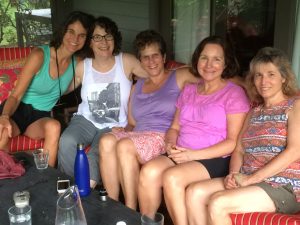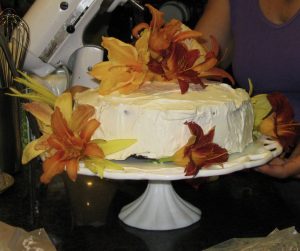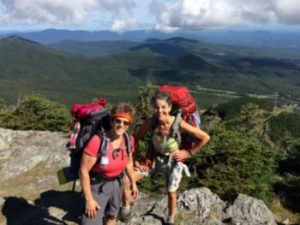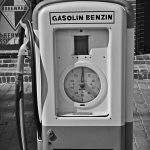On the trail, I learned a new attitude toward food.
When Jan and I started planning our trip, I imagined twenty-five days of oatmeal for breakfast, peanut butter for lunch, and rice and beans for supper.
Jan objected.
“We need variety,” she said. “And texture.” She was polite about rejecting a constant diet of mush.
Since Jan has a great deal more experience at extended backcountry expeditions, I acquiesced. “But we’ll make our own meals,” I insisted.
“Absolutely,” she agreed.
So we did.
Obsessed by Food
In my off-trail life, I’m obsessed with food, so inventing portable, quick-cooking, one-pot meals was a challenge I liked. I fired up my dehydrator and made tomato leather from homegrown tomatoes. I explored the grocery store in search of polenta that cooked in three minutes, ramen that cooked in four, and brown rice in ten.

Just before we left, three of our college housemates traveled to Vermont for a fabulous reunion and send-off.
In addition to growing, preserving and preparing food, I love to feed family and friends. In fact, the weekend before we started our hike, Jan and I feasted with college friends who traveled to Vermont to see us off.
As much as I love to feed others, I often resent how much time I spend thinking about and tempted by food. I love to eat, but I sometimes feel burdened by the variety and abundance of good food available from which I have to choose. I want to eat everything! Just seeing food can trigger my desire to eat even when I’m not hungry; it’s a daily struggle to not overeat.
We Couldn’t Overeat.
We couldn’t overeat on the trail. We could only eat what we carried with us: six days’ worth of granola for breakfast, crackers with bean spreads for lunch, and stews with venison jerky, dried salmon, or beans for supper. We also ate calorie-dense snacks several times a day: sweet snacks in the morning, and salty ones in the afternoon.
We ate when we were hungry. As soon as one of us said, “I need a snack soon,” we learned we needed to stop now. Despite our high calorie diet, we were both losing weight; without reserves, hunger could slam on our brakes.
We also each drank at least four liters of water daily. Filling our water bottles offered another strategic chance to rest and soak up the simplest of pleasures: a running brook, clean water, slaked thirst.
Since we were on our feet most of the day, we always sat down to meals, which in itself was a pleasure. At breakfast, we sipped our surprisingly good instant French roast and assessed the plans for the day. Lunch was a chance to slide off our packs, and dinner a chance to rest and reflect.
Thanks to exhaustion, I was more tired than hungry at the end of the day. After walking and talking for hours, we often fell silent while we waited for the water to boil and dinner to cook; we bent gratefully over our steaming bowls.
I ate slowly and savored my food, especially dessert. We carried just enough dark chocolate to enjoy a square each after dinner, which we chased with a swallow of bourbon at night.
The Lesson From the Long Trail
On the Long Trail, I came to appreciate food as fuel, and learned that surprisingly little can carry me a long way.
You can subscribe to receive an essay every Wednesday. Just enter your address in the box, click subscribe and check your email to confirm you’re a reader and not a robot.




Because I hope to End-to-End the LT one day, this post caught my eye. Deborah, as always, did NOT disappoint! I have done a few long-distance self-supported bicycle tours, but you have the advantage of stores along the way when cycling, so thru hiking and food was a concern! This post helps me to feel more confident and, hopeful, that I would be able to survive and add some variety to meals! I am okay with a relatively consistent diet as that is how I normally eat but I do like to change it up here and there. And I was worried about missing my VT craft beer, but substituting a little great bourbon and dark chocolate, makes giving up my VT beer more palatable!!! I am interested in what you had for your sweet and salty snacks. Are you willing to share? Thanks, as always, for a great post!!!
Hi Deb, My End-to-End was life-changing; I HIGHLY recommend it! And I’d be glad to give you any information you ask for, so let’s set up a time to meet or video chat or call. But here’s the brief answer: We usually shared a KIND bar – the grain type – in the morning. Also fruit leather (from plums I’d grown and dried). In the afternoon, we at mixes made from snacks we buy in bulk at the Coop: salted peanuts with rice crackers and wasabi peas (our favorite mix) and peanuts with sesame sticks and Inca corn (another great mix). We also carried powdered Gatorade – deplorable stuff that saved us during our afternoon slump. We made a light mixture and perked right up.
I’m glad to share any other info. I’m also giving a public talk about the trip in Brattleboro. Meanwhile, I’ve written a great deal about the trip on this blog as “Lessons From The Long Trail” which might be helpful.
Finally, depending on when you go and what your goals are, I’d be glad to deliver a resupply package and/or even join you for a day or overnight.
All best,
Deborah.